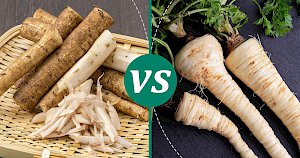Parsnips vs Burdock: Nutrition & Calories Compare


Parsnips vs Burdock
Nutrition Facts
Serving size:
change
5g10g15g20g30g40g50g60g80g100g120g140g160g180g200g220g250g300g350g400g450g500g600g700g800g900g1000g
1oz2oz3oz4oz5oz6oz7oz8oz10oz12oz15oz20oz25oz30oz35oz40oz50oz
Amount Per Serving:
Serving size:
change
5g10g15g20g30g40g50g60g80g100g120g140g160g180g200g220g250g300g350g400g450g500g600g700g800g900g1000g
1oz2oz3oz4oz5oz6oz7oz8oz10oz12oz15oz20oz25oz30oz35oz40oz50oz
Amount Per Serving:
Parsnips vs Burdock 100g Compare
| per 100g | Parsnips | Burdock |
|---|---|---|
| Calories | 75 | 72 |
| Carbohydrates | 17.99 g | 17.34 g |
| Fat | 0.3 g | 0.15 g |
| Dietary fiber | 4.9 g | 3.3 g |
| Protein | 1.2 g | 1.53 g |
| Calcium | 36 mg | 41 mg |
| Iron | 0.59 mg | 0.8 mg |
| Magnessium | 29 mg | 38 mg |
| Phosphorus | 71 mg | 51 mg |
| Potassium | 375 mg | 308 mg |
| Sodium | 10 mg | 5 mg |
| Zink | 0.59 mg | 0.33 mg |
| Vitaminium B1 (Thiamine) | 0.09 mg | 0.01 mg |
| Vitaminium B2 (riboflavin) | 0.05 mg | 0.3 mg |
| Vitaminium B3 (Niacin) | 0.7 mg | 0.3 mg |
| Vitaminium B5 | 0.6 mg | 0.321 mg |
| Vitaminium B6 | 0.9 mg | 0.24 mg |
| Vitaminium B9 (Folic acid) | 67 mg | 23 mg |
| Vitaminium C | 17 mg | 3 mg |
| Vitaminium K | 22.5 µg | 1.6 µg |
Exploring the Nutritional Landscape of Parsnips and Burdock
When it comes to root vegetables, parsnips and burdock might not be the first to come to mind, overshadowed often by their more common cousins like carrots and potatoes. Yet, these two roots offer a wealth of nutrients and interesting culinary uses that deserve a closer look. From historical uses in traditional medicine to their presence in modern kitchens, parsnips and burdock are more than meets the eye.
The Tale of Two Roots
Parsnips, with their creamy white flesh, are often associated with winter meals and comfort foods. They have been cultivated since ancient times and were a staple in the diet before the potato made its way to Europe. On the other hand, burdock is celebrated in Asian cuisines, particularly in Japan, where it's known as gobo. Its earthy flavor and crisp texture make it a favorite in dishes like kinpira gobo (braised burdock root).
Nutritional Face-Off
When comparing the nutritional profiles of parsnips and burdock, it's evident that both offer significant health benefits, though in slightly different packages. Here's a brief rundown of their nutritional content per 100g serving:
- Calories: Parsnips contain slightly more calories at 75, compared to burdock's 72.
- Carbohydrates: Both are similar in carb content, with parsnips at 17.99g and burdock at 17.34g.
- Fiber: Parsnips lead with 4.9g of fiber, while burdock has 3.3g, making both excellent for digestive health.
- Protein: Burdock slightly edges out parsnips with 1.53g of protein.
- Minerals: Burdock provides more iron and magnesium, whereas parsnips offer more potassium.
- Vitamins: Parsnips are rich in vitamins C and K, while burdock provides a good amount of vitamin B2.
Both parsnips and burdock are low in fat and contain no cholesterol, making them heart-healthy choices. They also boast an array of minerals like calcium, phosphorus, and zinc, crucial for bone health, energy production, and immune function, respectively.
Culinary Uses and Tips
When it comes to incorporating these roots into your diet, the possibilities are as varied as their nutritional profiles. Parsnips can be roasted, mashed, or added to soups and stews for a sweet, nutty flavor. They also make a great addition to root vegetable medleys. Burdock, with its slightly artichoke-like taste, can be julienned and sautéed, pickled, or used as a crunchy addition to salads.
One tip for preparing parsnips is to peel them lightly, as the outer skin can be tough. For burdock, soaking the slices in water with a little vinegar can prevent discoloration and reduce any bitterness.
Final Thoughts
While both parsnips and burdock offer unique flavors and nutritional benefits, your choice between them might come down to personal taste or specific dietary needs. Whether you're looking to boost your fiber intake, add more minerals to your diet, or simply explore new flavors, these root vegetables are versatile and nutritious options worth considering. So next time you're at the market, why not pick up a bunch of each and experiment in your kitchen?
Parsnips 100g
75kcalCalories source
- 91% CARBS.
- 6% PROTEIN
- 3% FAT
Burdock 100g
72kcalCalories source
- 90% CARBS
- 8% PROTEIN
- 2% FAT
Compares of parsnips
- Parsnips vs Asparagus
- Parsnips vs Bamboo Shoots
- Parsnips vs Beetroot
- Parsnips vs Butternut Squash
- Parsnips vs Carrot
- Parsnips vs Cassava
- see all compares of parsnips
Marcin Piotrowicz
calories-info.com creator
Healthy diet and healthy lifestyle promoter
Add comment